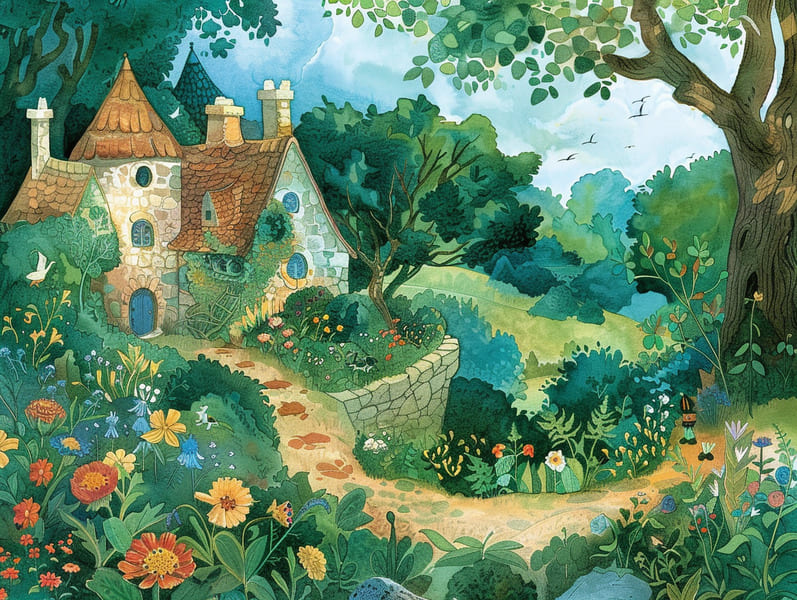
Famous fairy tales have timeless appeal. These tales have been spoken from one generation to the next long before they were ever put on paper. They arose from a variety of traditions, including American traditions. They were initially conveyed among grown-ups, often carrying themes and messages reflective of the societal norms and beliefs of the time.
Jacob and Wilhelm Grimm, Jacob and Wilhelm, were among the first to gather many of these beloved tales. Their published works, "Grimm's Folk Tales," included tales like "The True Bride," "The Story of Hansel and Gretel," and "Little Snow White," which have since become hallmarks in the world of children's fairy tales. Similarly, H. C. Andersen's fantastical stories, such as "The Mermaid's Tale," and "The Duckling's Story," have gained the love worldwide, guaranteeing their place in the pantheon of famous fairy tales.
Even though they are old, these tales remain as significant as ever, especially as children's bedtime stories. These delightful tales are now available in multiple formats, including vibrantly illustrated books, enchanting animations, and digital storybooks.
Their persistent charm can be ascribed to several fascinating points:
Significant Morals: Timeless fairy tales often offer important moral lessons. Narratives like "The Tale of the Boy Who Cried Wolf" teach the importance of sincerity, while "The Story of the Tortoise and the Hare" highlight the virtues of persistence and humbleness. These tales offer kids clear distinctions between good and bad, developing their moral compass in a mild yet profound way.
Kindness and Comprehension: Fairy tales frequently feature personalities facing challenges and struggles, urging young listeners to resonate with their struggles and encourage their triumphs. For instance, "The Story of Beauty and the Beast" shows us the benefit of seeing inner beauty to know the true character of a character, enhancing compassion and perception.
Cultural Comprehension: Many ancient fairy tales are rich in the cultural contexts from which they arose. Reading these stories can provide fascinating glimpses into different traditions, advancing a sense of cultural appreciation and appreciation.
Creativity and Imagination: The extraordinary elements in fairy tales—enchanted objects—stimulate children’s fantastical thinking. These tales bring readers to enchanted realms, kindling inventive ideas and a sense of astonishment that endures a lifetime.
Traditional fairy tales are not only charming but also teaching. They serve as alluring tools in building various brain and heart skills in the young. When timeless fairy tales are spoken, they foster language skills by bringing new terms and meanings and sophisticated sentence structures. This practice also enhances auditory skills and mindfulness, as young readers listen intently, eager to see what happens next.
Furthermore, contemplating the themes and characters of timeless fairy tales can nurture critical thinking and reasoning skills. Kids are educated to discern patterns, anticipate outcomes, and know cause and effect. These talks also encourage young ones voice their thoughts and feelings, adding to their emotional intelligence.
In today’s modern era, the abundance of internet fairy tales has made these fairy tales more reachable than ever. Websites and apps share extensive collections of Grimm's fairy tales that can be explored or heard anytime, anywhere. Fairy tales read aloud are particularly sought after, making available an interactive method for young readers to be a part of these charming stories. Spoken stories and voiced videos guide characters and settings to life, often accompanied by whimsical harmonies and background music that improve the tale journey.
The timeless charm of classic fairy tales lies in their ability to change to present eras while holding onto their fundamental ideas. Contemporary revisions of these stories often present more inclusive protagonists and modern settings, making them understandable to today’s audience. However, the core values of gallantry, generosity, and lawfulness remain unchanged, continuing to strike a chord with audiences of all ages.
Traditional fairy tales also offer a sense of calm and knowability. They bestow a coherent narrative with a unmistakable beginning, middle, and end, often ending with the resolution of conflicts and the triumph of honesty over deceit. This predictability can be solacing for kids, granting a sense of assuredness in an ever-changing world.
Ancient fairy tales continue to enchant and teach new generations, maintaining their delight and pertinence in modern society. As children's bedtime stories, they deliver up a perfect blend of allure and teaching, supporting moral values, empathy, and creativity. The abundance of internet fairy tales and the widespread nature of fairy tales told out loud certify that these ancient fairy tales remain available to new generations.
By holding onto and disseminating these fairy tales, we continue to admire the rich tapestry of tales and cultural heritage. Whether you are perusing a vividly illustrated book, accessing a digital library, or listening via an voice book, the delight more info of popular fairy tales is always within reach. These stories reveal of the invariable spell of stories and its ability to draw us together across epochs and places.
Be it you are experiencing a vividly illustrated book, experiencing a electronic collection, or playing an audio story, the captivation of timeless fairy tales is always within reach.
These fairy tales highlight of the immortal ability of storytelling and its ability to join us across epochs and places, establishing a link that fascinates and enlightens alike.